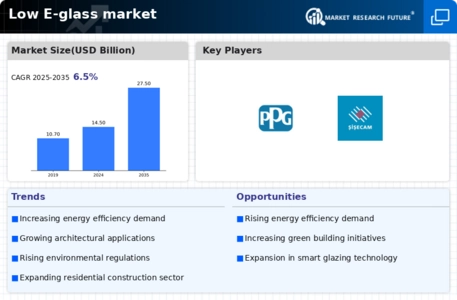Market Trends
Key Emerging Trends in the Low E Glass Market
The Low E Glass market is undergoing significant transformations influenced by factors such as energy efficiency awareness, advancements in glass coating technologies, and sustainable building practices. Rising Demand for Energy-Efficient Solutions: A major trend in the Low E Glass market is the escalating demand for energy-efficient solutions in the construction and automotive sectors. Low E (low emissivity) glass is designed to minimize heat transfer through windows by reflecting infrared radiation, making it a key component in enhancing energy efficiency in buildings and vehicles. The increasing awareness of energy conservation is driving the adoption of Low E Glass in various applications. Advancements in Coating Technologies: The market is experiencing continuous advancements in coating technologies applied to Low E Glass. Manufacturers are developing innovative coatings that optimize solar control, improve thermal insulation, and enhance overall performance. These technological advancements contribute to the customization of Low E Glass to meet specific requirements, such as varying climates and building orientations. Growing Focus on Sustainable Construction: The construction industry's growing emphasis on sustainable and green building practices is influencing the Low E Glass market. Low E Glass, with its ability to reduce energy consumption for heating and cooling, aligns with sustainability goals. Architects and builders are incorporating Low E Glass in the design of energy-efficient buildings, contributing to eco-friendly construction practices. Increasing Stringency of Building Energy Codes: The tightening of building energy codes and regulations is a notable trend impacting the Low E Glass market. Governments and regulatory bodies are implementing stricter standards to improve the energy performance of buildings. Low E Glass, being a key component in meeting these standards, is witnessing increased demand as builders strive to comply with energy efficiency requirements. Expansion in Automotive Glazing: The use of Low E Glass is expanding beyond the construction sector into automotive glazing. In the automotive industry, Low E Glass contributes to improved thermal comfort by reducing heat transfer through windows. As automakers focus on enhancing the energy efficiency and comfort of vehicles, the adoption of Low E Glass in automotive applications is gaining momentum. Variety of Low E Coating Options: The market offers a variety of Low E coating options to cater to diverse needs. Single-silver, double-silver, and triple-silver coatings are among the options available, each offering specific benefits in terms of solar control, visible light transmission, and insulation. This variety allows consumers and businesses to choose Low E Glass products that best suit their requirements. Integration with Smart Building Technologies: The integration of Low E Glass with smart building technologies is an emerging trend. Low E Glass can be part of intelligent building systems that dynamically adjust to external conditions, optimizing energy efficiency. This trend reflects the broader movement towards smart and sustainable buildings equipped with advanced technologies for energy management. Global Market Expansion: The Low E Glass market is witnessing expansion on a global scale. Regions with extreme climates, both hot and cold, are recognizing the value of Low E Glass in maintaining indoor comfort and reducing energy costs. The market's global expansion is driven by the increasing recognition of the benefits of Low E Glass in diverse climatic conditions.


 Source: Primary Research, Secondary Research, Market Research Future Database and Analyst Review
Source: Primary Research, Secondary Research, Market Research Future Database and Analyst Review


Leave a Comment